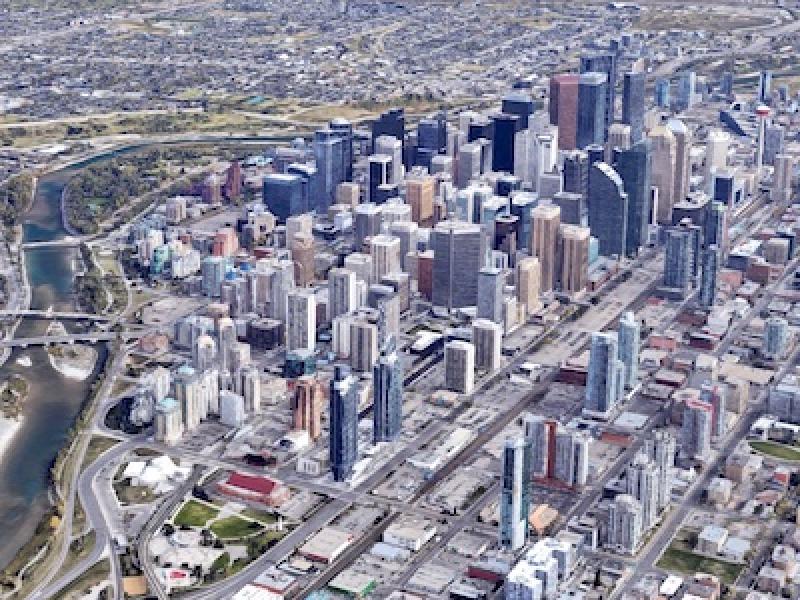
Creating amenity-rich buildings along with the continued conversion of under-utilized space are keys to lowering the sky-high vacancy rate for downtown Calgary office towers.
Aspen Properties executive chairman Scott Hutcheson told attendees at Thursday's Calgary Real Estate Forum his company isn’t currently competing against other real estate companies such as Oxford or Brookfield.
“We’re competing against the kitchen table of work-from-home. That’s really what office space has to be: more exciting than your kitchen table,” Hutcheson said. "So in order to deliver a product like that for our tenants, we went amenity-rich many years ago when we created the Edison (a redeveloped and re-branded downtown office building).
“Initially we figured it was to attract the tech community to the Edison and then we realized that the tech community wants exactly the same space as the banks do, or the accounting firms, or the financial institutions. We all want cool space. We all want space that we can go to and have great gathering spaces and an active common space.
“We’re putting golf simulators in our buildings. In the Ampersand, our newest product, we put a basketball court right in the main lobby. So this is the kind of stuff we have to do today to make space cool.
"Every employer today really wants their employees to come to work. Most employees want more flexibility. So what we’re doing is trying to build spaces for employers, which then can get their employees to come to work if it’s an exciting place to be, and I don’t care whether you’re a tech company or whether you’re somebody my age.
"We all want the same space. We want fresh, clean, new, lots of amenities and really exciting places to go. And that’s where you build culture. We don’t build cultures over screens. We build culture face-to-face, in gathering places, talking and using each other’s chemistry and energy.”
The stats and the focus on amenities
In recent years, Aspen renovated both its Edison and Ampersand properties to add those "rich" amenities.
Hutcheson said the company has completed about 480,000 square feet of new leasing this year in the Ampersand, in a flat market, as proof that amenity-rich buildings do attract people.
According to commercial real estate firm CBRE, the overall downtown office vacancy rate in Calgary was 32.9 per cent in Q3 in an overall inventory of just over 43 million square feet.
Net absorption in the third quarter was 366,837 square feet. The class-A vacancy rate was 27.3 per cent.
Direct vacant space was 11,348,422 square feet while sublet was 2,813,801 square feet. Sublet space as a percentage of the overall vacancy was 19.9 per cent.
Hutcheson said the downtown office market has become a "move-up" market. If you have an obsolete building in the west end of the downtown core that is small and doesn’t have amenities, it will likely empty out. But a better building that is centrally located, with lots of amenities, will be able to retain occupants and sign new tenants.
“So you’re seeing a market shift and you know you’ve got 30 per cent vacancy. All we really care about is we get warm bodies in our buildings and we’ll sign a two-, three-year deal because that’s what the market’s asking us to do,” he said.
“The bigger the company is, the more it’s downsizing its number of square feet. The smaller the company is, the more they’re growing. That’s what we’re seeing.
"The other trend that we’re seeing with office users is that the bigger our tenant is, the less the employees come to work. And the smaller our tenant is, the more employees on a percentage basis come to work.
"So it’s a really different cultural difference.”
Genesis of Calgary's Greater Downtown Plan
Calgary Mayor Jyoti Gondek said the city’s downtown office buildings historically were 100 per cent utilized as office space. That is no longer the case.
“You might have a couple of amenities on the base floor, but we weren’t very good at that.
"We built the downtown totally focused on office space for big headquarters . . . I remember 2014 and '15, Scott and I were both on the real estate advisory committee . . . we started challenging convention and saying ‘How do we invite different uses into downtown buildings and if we do get that permission to have different uses how do we convert the spaces to actually mirror what those uses need?’ ” she said.
“We spent a long time trying to figure out how to get conversion right. Edison and Ampersand are both excellent examples. We learned from the private sector as a government and so last year when we approved the downtown revitalization strategy and built in $100 million as incentives for conversions from office to housing as the first phase, it’s been successful because we listened to the experts, they listened to the community and we all work together.
“When we talk about 770,000 square feet of office space being repurposed into 704 housing units, that’s a big deal. We are now being written about as a city to watch.”
The goal of the Greater Downtown Plan in Calgary is to remove or repurpose six million square feet of office space. An investment of $450 million is required over the next decade to do that.
The city is granting developers $75 per square foot as an incentive to convert downtown office space.
Future plans could include post-secondary uses or other office uses to reduce the vacant space. Potential demolition is also a possibility.
Case study for office conversion
For example, Aspen is one of several developers undertaking conversion projects on one of its office properties. It is converting about 200,000 square feet of office space in its Palliser One property to 176 apartments, featuring a mix of one- and two-bedroom units.
The 27-storey office building on the east side of the Calgary Tower has close to 400,000 square feet of total space.
The residential component of the tower will be the top half of the building – two elevator banks at the base will service the residential and the office separately.
Greg Guatto, president and CEO of Aspen, said the company has an additional 1.2 million square feet of density on the site.
“So we really hope that this is the catalyst to kick off a lot more residential on this site,” said Guatto.
Thom Mahler, director of downtown strategy for the City of Calgary, said a big part of the Greater Downtown Plan is creating neighbourhoods for vibrant, urban life. The plan also includes "greening" the core, making the streets places where people can congregate and hang out and live, and enhancing transit services.
Guatto said the city has a property tax problem. With the value of downtown office property declining substantially since 2015, that property tax burden is being redistributed and pushed outside of the core.
“There’s been a $16 billion decrease in value of office product in the downtown core since 2015. That translates into $320 million of property taxes and as we all know, it’s a zero-sum game that has been pushed elsewhere and that burden is being carried by everybody else,” he said.
The Greater Downtown Plan is important to help rebuild downtown values and ease that tax issue, but it’s also “critical” to attract and retain talent in the city, Guatto noted.










